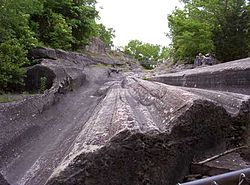
Back Ледавіковая штрыхоўка Byelorussian Souvek Czech Skurestribe Danish Kritzung German Estría glaciar Spanish Glaziar ildo Basque Jäätikköuurteet Finnish Strie glaciaire French Jökulrák Icelandic Striatura glaciale Italian


Glacial striations or striae are scratches or gouges cut into bedrock by glacial abrasion. These scratches and gouges were first recognized as the result of a moving glacier in the late 18th century when Swiss alpinists first associated them with moving glaciers. They also noted that if they were visible today that the glaciers must also be receding.[1]
Glacial striations are usually multiple, straight, and parallel, representing the movement of the glacier using rock fragments and sand grains, embedded in the base of the glacier, as cutting tools. Large amounts of coarse gravel and boulders carried along underneath the glacier provide the abrasive power to cut trough-like glacial grooves. Finer sediments also in the base of the moving glacier further scour and polish the bedrock surface, forming a glacial pavement. Ice itself is not a hard enough material to change the shape of rock but because the ice has rock embedded in the basal surface it can effectively abrade the bedrock.
Most glacial striations were exposed by the retreat of glaciers since the Last Glacial Maximum or the more recent Little Ice Age. As well as indicating the direction of flow of the glacial ice, the depth and extent of weathering of the striations may be used to estimate the duration of post-glacier exposure of the rock.
An outstanding example of glacial grooves can be found at the Glacial Grooves at Kelleys Island, Ohio (a National Natural Landmark), the most impressive of which is 120 metres (400 ft) long, 10 metres (35 ft) wide, and up to 3 metres (10 ft) deep. These grooves cut into the Columbus Limestone. Striations cover the sides and bottoms of the grooves.
Other examples of glacial striations can be found in the former path of the Moiry Glacier, south of Grimentz, Anniviers, Valais, Switzerland, alongside the present path of the glacier, north-east of the 2016 location of the tongue of the glacier (images).
- ^ Easterbrook, Don (1999). Surface Processes and Landforms. Upper Saddle River, New Jersey: Prentice Hall. pp. 315–317. ISBN 0-13-860958-6.